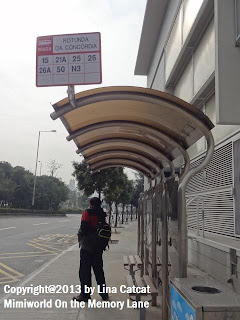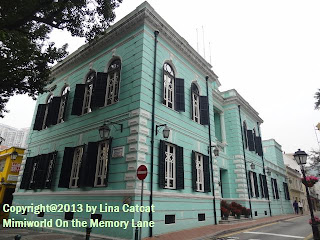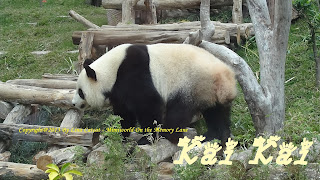Continued from Day 4 (Pt 1). We boarded the free shutter bus at the impressive classical Chinese style-gate next to the Esso Petrol station on the road as the bus is waiting at the gate that leading through hill slope of the lush forest and the bus was nearly full passengers including ourselves. In less than 5 mins, the bus started to drive up the lush forest which is the quite steep along the road path and it would take us about 15 mins to reach at the top of the hill where A-Ma Cultural Village and A-Ma Statue are.
A-Ma Cultural Village
Stairs of Stone-craving of the Roaring Tiger
A-Ma Cultural Village, the Qing Dynasty style complex that lies at the 170m peak of the mountaintop on Macau's Coloane Island and culture village is about 7,000 sqm that celebrated the beloved deity's legend and it is a pleasant and beautifully surrounding culturally rewarding. We were greeted by six rows of stairs carved with auspicious Chinese patterns like of the roaring tiger, the double lion, the five cranes and double phoenix that lead to the Tian Hou Palace. It was started its development in 2001 during Chung Yeung Festival shortly after the A-Ma Cultural and Tourism of Macau.
Close-up of the interior design
It comprises of a bell tower, a drum tower, carved marble altar in the A-Ma Palace, a dressing hall, museum, shops that will attract the A-Ma devotees and tourists from Asia countries where the goddess A-Ma is believed to be around 1,000 years ago.
Statue of A-Ma
The Statue of A-Ma is close to the world's tallest and is the protector of people who made the living of the sea, located on the top of Coloane Hill (Alto dee Coloane). A-Ma is designed by local sculptor and beautifully carved (China) of white marble, the statue stands 19.99m high and can be seen from miles around. It imparts a sense of peace and serenity, as well as being an spot for phototaking the Pearl River Delta area
Side View of the bell tower and its turtles
Centre View of Tin Hau Palace
Anicent Chinese-style Burner
After we walked around for an hour within the compounds, took lots of photos seems never ending as it is such a huge spectacular cultural village and the Tin Hau Palace's rooftop, there is a Pagoda and two Dragons stood on each side of the Pagoda. Shortly after that, we walked down the stairs to catch the shutter bus at the base of the stairs and takes us to the base of the hill near the gate where we were from. The shutter bus comes in every thirty mins interval.
Bus-stop opposite the Chinese-style gate
After the bus reached at the base of the hill, we crossed the road just opposite the Chinese-style gate, to take a public bus no 15 to the next destination - "Taipa Houses-Museum", "Islands of Lingering Grace Exhibition on Macanese Culture" and "Museum of Taipa and Coloane History" and so on.
Retro Design of the Building
After we reached at the destination, we walked along the road that leads to the Taipa Houses-Museum as well as Museum of Taipa and Coloane History. The road is a circular shape with eerie old buildings that no one lived but this place is well protected by security on this island.
The small house with no windows
This traditional old house looked an ancient house of China-era with one door that has no windows build on it. The road paths were made of cobblestones along the slope passageway that one could hardy walk up the slope.
Carmo Hall
Our Lady of Carmel Church
Our Lady of Carmel Church built in 1885, stands on the hill overlooking the sea. Taipa village and the restored mansions of old Taipa Praia. Being the only Catholic church in Taipa, it is famed for a nearby park where the visitors can rest their feet and enjoy the plant biodiversity in the park. Some wedding couples come here to have a photo shot of their selected wedding location and I spotted them and took a photo before heading towards the Taipa Houses-Museum.
Taipa Houses-Museum
The Taipa Houses-Museum comprises of five old houses built in1921 located at Avenida Da Praia, displaying various artifacts and exhibits. The five houses are named "Macanese House", "House of the Island", "House of the Portugal Regions, "Exhibition Gallery" and "House for Reception". These five Houses had been the residence of high superiors and Macanese family in the decades and eventually bought by Macau Government in 1980s, remodel them into beautifully designed, recognising its important architectural value, thus reforming into museum and renaming the five houses as above information lists from the website here. I took one of the Taipa Houses - Macanese House
Macanese House
Macanese House is one of the Macau's typical houses during colonial days and the reminder of the ancient Portuguese splendor that was characterized by frequent affluence of the Portuguese, British, Mandarins and wealthy merchants in this small territory.
Side view of Taipa Houses-Museum
I managed to take side view of the five Taipa Houses-Museum distance from the sea view where the carmo garden is.
Free Phototaking of Trishaw Rider beside Taipa Houses
Photoshot of Wedding Couple at the Taipa Houses-Museum
I saw the wedding couple sitting gracefully at the corridor of Taipa Houses, would bring a memorable of their wedding day. There is a free photo-taking of Trishaw Rider that parks beside one of the Taipa Houses.
Windmill at Municipal Garden
Sculptures at Municipal Garden
At the Our Lady of Carmel Church that leads to the Carmo Square that is nearby to the Taipa Houses-Museum just walk a short distance. These beautifully sculptures of different animals on each side of the garden with sea view. And also lookover the landscape and you will see the city landscape of Cotai Strip Hotels and Buiildings.
The street of Trevessa De Santa Gertrudes
As we walked along the street of Trevessa De Santa Gertrudes and leads us to the small Kuan Yin temple.
Kuan Yin Temple
Cunha Bazaar and Old CheryKoff
Koi Kei Pastry shop, Post box and Trishaw Rider
This silver of a pedrestian street is just 5m wide and stretching about 115m that packed in a dozens of snack shops and eateries, is a small commerical buildings with colourful background on the wall to appealing tourists' attraction. The colourful colonial architecture and the folks of different culturally overwhelming the locals and tourists alike. The heaven smell of pastries, peanut candy, pork and beef jerky when we went near it and thus make us feel hungry. There is even tasting of samples on each shop too. There are also red posting box ( different from the first Day 2 pic 1 and Day 2 pc2 ) and trishaw rider stood in front of Koi Kei pastry shop.
Cozinha Pinocchio Restaurant
Cozinha Pinocchio Restaurant is one of the most famous restaurants in Taipa and they specialise in Macanese cruisine. The building is super huge and looks spectacular from the side view and the restaurant has been around more than 30 years.
The Paint Graffiti of Cunha Bazaar
The wall of Cunha Bazaar is full of hand-painted with colourful streets of Taipa village in olden times. I heard that the grand opening of Cunha Bazaar was on the 22rd Sept 2011 and was a collaborative effort between The Choi Heong Yuen Bakery and Macau Creations. The out most wall of this four-storey building is hand-painted with the traditional colors of Macau.
Pastelaria Fong Kei
This shop is a century old pastry shop Fong Kei is the next big draw to the crowds on Rua Do Cunha. Well, this place is for the local people who want their cakes and their steak and to eat it on the open space and a takeaway box too. The shop makes cookies with port and lard fillings. It sounds like doggy biscuits but it tastes like humans culinary genius, as evidenced by the perennially long queue outside Fong Kei. Almond cookies with pork filling are their signature. We were not at Koi Kei pastry shop and there's no testings and it could cost cheap. Do try to be a good shopper and just order quickly and without any problem to ask otherwise you will get the evil eye if dilly dallying. A long queue is a maker of great meat cookies.
Museum of Taipa and Coloane History
We walked along the street of Rua Do Regedor to where there is a history museum called - Museum of Taipa and Coloane History was formerly known as a Public Administration building located at Rua Do Meio. The 2-storey Museum of Taipa and Coloane History consists of exhibitions of the historical relics unearthed in Coloane, stone architectural remains and the development of the villages, religions and culture of the islands provide an overview of the history and culture of old Coloane and Taipa. There is a Pak-Tai Temple within a few short walk from the Museum. The 1st floor level is a ancient history where there is a collection of relic spaning from the Han Dynasty and Qing Dynasty are on display, reflecting the ancient history of Taipa and Coloane. Also the Prehistory of Civilization that display prehistory stonewares like stone net weight and sharp and pointed tools as well as sketches of the archaeological findings and stratigraphies of the earth layers from the Hac Sa Site. NO photography is allowed on 1st floor level.
Farmer's tools (2nd floor level)
One of the utensils in this picture on the left (2nd floor level) is a wooden bucket (mid 20th century) used by fish sellers to carry fish. In the past, the salt fish industry was very prosperous in Taipa and Coloane. The salted fish were kept in wooden buckets for transportation. On the centre of the picture is the Shrimp paster stone grinder, is the processing tool for makeing shrimp paste, miniscule white shrimp were crushed and ground in the stone grinder to make smooth and the shrimp paste.
Stone Mill
The stone mill is a processing tool for grain products, comprises upper and lower of millstones used for grinding grain foodstuffs. In the past, the farmer of Coloane and Taipa would grind paddy rice for rice milk to make rice cakes.
Chinese Weapons
The Chinese weapons (2nd floor level staircase) exhibited in the building of former Municipal Council of the Islands.
Firecraker Trimming Maker (2nd floor level)
A tool is used by the firecraker factories to make fuse powder in the olden times. Wood charcoal and self-peter were the major raw materials in making fuse powder, and the wood charcoal had to be grounded in this wooden before use. In the late 1960, many factories started to used this kind of wooden grinder that driven by a machine, as the result this old wooden device was gradually eliminated.
There is also the sculpture of the beam of the old sailing fishing boat above the ceiling.
The Ancient Bell (2nd floor level)
At the Tin Hau Temple, there was once an ancient bell from the past which you may not see it and now it is displayed at the Museum of Taipa and Coloane History. This ancient bell is exhibited from the Tin Hau Temple by the effort of the Civil and Municipal Affairs Bureau (IACM) in converving the relics of the temples in Taipa supported by the Association. The ancient bell is more than two hundred year old, ancient relic of the bell and the frontal inscription reads " the nation flourishes and its people live in peace". The "Tin Hau Temple of Long Tau (Dragon Head) Bay, dated on 50th year of reign of Emperor Qianglong (1785). A 'Bell' performs an important function and high status of the temple and devotees pay their homage to gods and strike the bell, notifying the gods about their visit.
Horizontal Tablet of Jing Zhan Shan En
The tablet in the middle is a scroll, while boy statues are engraved on both sides and the bottom decorated with bats. The main text in the middle and the signature are engraved in relief. This tablet lent by Coloane Si Miao Ci Shan Hui.
First floor of red carpet staircase
It is such beautiful 'red carpet' on the grand staircase that looks new and spacious area. I felt to be able to take a photograph of myself with the help of my hubby and also group photo is taken by the friendly staff of the museum.
In front of the staircase, there is a "Tin Hau' statue, which is a original model of the Tin Hau statue located at the Mount Coloane.
Dog's Poop (WC)
After walking around the museum, we took a public bus no 28A which is near the corner of the building at RuaCorreria Da Silva, to the 4-faces Buddha Shrine located along Estrada Governador Albano Oliveira next to the Macau Jockey club and Casino Taipa Square. As we alighted at the junction, continued walking along the road till we saw the most clean place of an animal doing business on the spot - Dog's Poop (WC) where you may not see in Singapore. Well, you may say Macau is clean without any dog's poop on the roads and there is a spot for the owners' doggy for doing business. And yes, I did see the cute dog - Chihuahua at the Senado Square where there is a dog's WC around the corner of the building. Will Singapore follow this example instead of letting the dogs peeing and pooping on the roads and building's footpaths? This is to educate for the dog owners for cleanliness and health of the people who passing by.
Four-faces Buddha Shrine
Casino Taipa Square
Macau Jockey Club
Another popular of Taipa attraction, seated in a Thai Style pavilion, surrounded by stone elephants, mythical birds and flower wreaths, the gold-leaf clad statue is a popular "praying stopover" for gamblers on their way to the Macau Jockey Club just next to it as well as Casino Taipa Square. The magnificent 4-faces Buddha consists of four elements - earth, water, fire and air.
Bus-stop at Grandview Hotel
As it's getting late for us and we headed to the bus-stop at the corner of Grandview Hotel, took a public bus no 26 or MT4 heading towards our hotel in Cotai in 20 mins. As we were still waiting for the bus no.26 but it will take a longer time about 30mins waiting time. We somehow took bus no MT4 which arrives every 10 mins interval that would faster than normal bus no 26.
Girl dances on the rings
As soon as we boarded the bus no MT4 when it arrives earlier and reached to our hotel in 20 mins and the weather is still freezing cold at nights and drop about 13 degrees C. At the lobby of our hotel, there is another show at night - Girl dances on the Rings at the Paradise garden in front of "God of Fortune". It is indeed a spectacular sight.
After the show, we headed to our dinner at foodcourt and soon walked back to our hotel to rest as we were tired throughout the whole day.
The following morning, we headed to the other popular exhibitions at nearby neighbouring hotels just opposite from our hotel in my next blog.
























































































